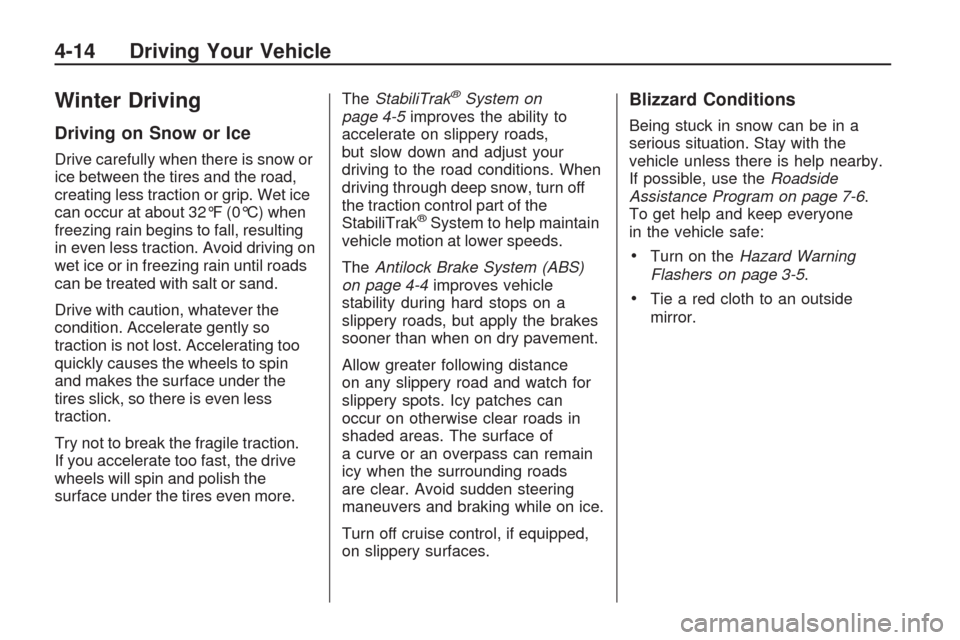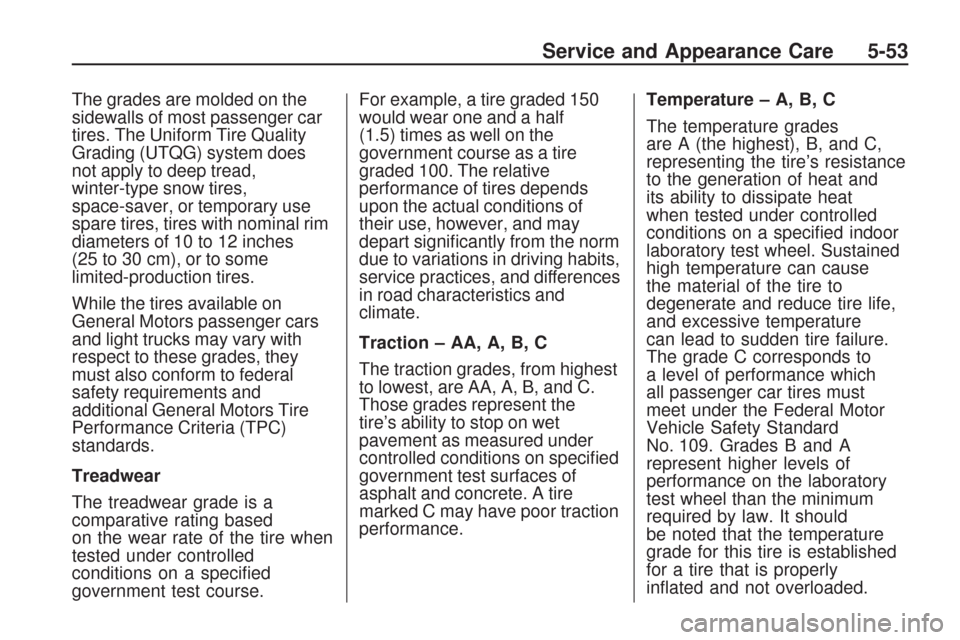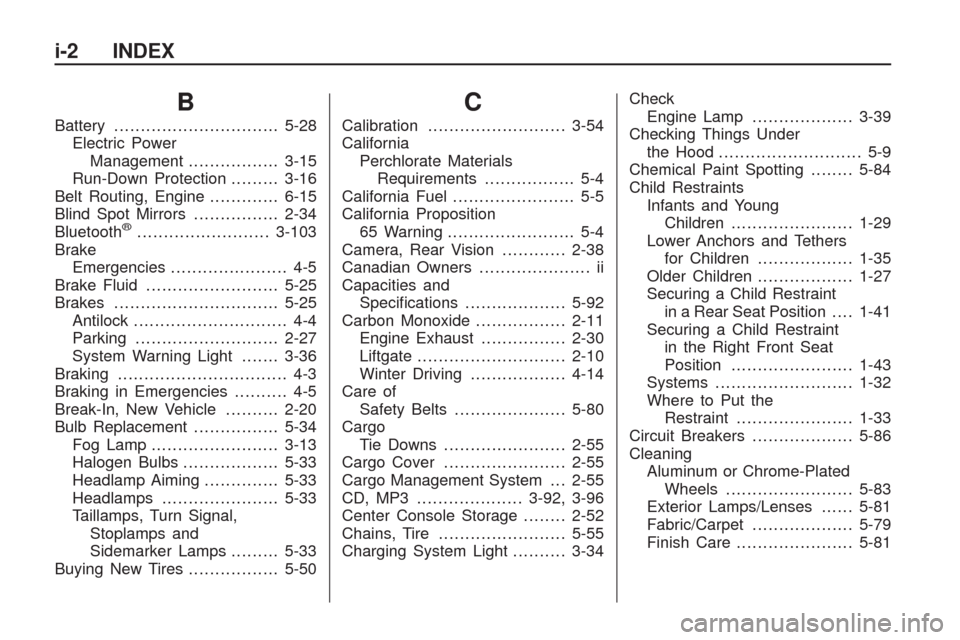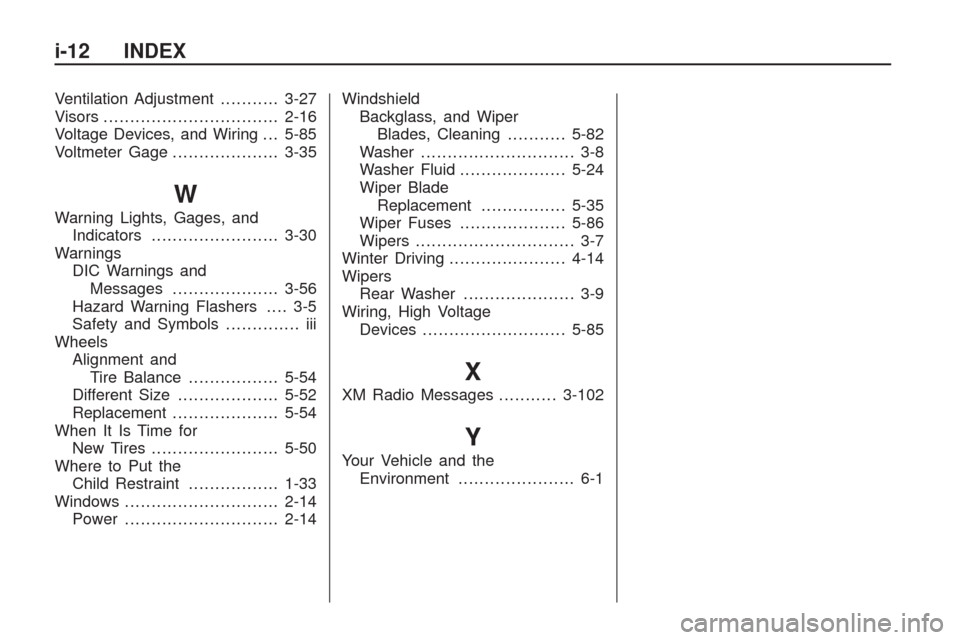winter tires CHEVROLET TRAVERSE 2009 1.G Owners Manual
[x] Cancel search | Manufacturer: CHEVROLET, Model Year: 2009, Model line: TRAVERSE, Model: CHEVROLET TRAVERSE 2009 1.GPages: 422, PDF Size: 2.06 MB
Page 262 of 422

Winter Driving
Driving on Snow or Ice
Drive carefully when there is snow or
ice between the tires and the road,
creating less traction or grip. Wet ice
can occur at about 32°F (0°C) when
freezing rain begins to fall, resulting
in even less traction. Avoid driving on
wet ice or in freezing rain until roads
can be treated with salt or sand.
Drive with caution, whatever the
condition. Accelerate gently so
traction is not lost. Accelerating too
quickly causes the wheels to spin
and makes the surface under the
tires slick, so there is even less
traction.
Try not to break the fragile traction.
If you accelerate too fast, the drive
wheels will spin and polish the
surface under the tires even more.TheStabiliTrak
®System on
page 4-5improves the ability to
accelerate on slippery roads,
but slow down and adjust your
driving to the road conditions. When
driving through deep snow, turn off
the traction control part of the
StabiliTrak
®System to help maintain
vehicle motion at lower speeds.
TheAntilock Brake System (ABS)
on page 4-4improves vehicle
stability during hard stops on a
slippery roads, but apply the brakes
sooner than when on dry pavement.
Allow greater following distance
on any slippery road and watch for
slippery spots. Icy patches can
occur on otherwise clear roads in
shaded areas. The surface of
a curve or an overpass can remain
icy when the surrounding roads
are clear. Avoid sudden steering
maneuvers and braking while on ice.
Turn off cruise control, if equipped,
on slippery surfaces.
Blizzard Conditions
Being stuck in snow can be in a
serious situation. Stay with the
vehicle unless there is help nearby.
If possible, use theRoadside
Assistance Program on page 7-6.
To get help and keep everyone
in the vehicle safe:
Turn on theHazard Warning
Flashers on page 3-5.
Tie a red cloth to an outside
mirror.
4-14 Driving Your Vehicle
Page 335 of 422

The grades are molded on the
sidewalls of most passenger car
tires. The Uniform Tire Quality
Grading (UTQG) system does
not apply to deep tread,
winter-type snow tires,
space-saver, or temporary use
spare tires, tires with nominal rim
diameters of 10 to 12 inches
(25 to 30 cm), or to some
limited-production tires.
While the tires available on
General Motors passenger cars
and light trucks may vary with
respect to these grades, they
must also conform to federal
safety requirements and
additional General Motors Tire
Performance Criteria (TPC)
standards.
Treadwear
The treadwear grade is a
comparative rating based
on the wear rate of the tire when
tested under controlled
conditions on a speci�ed
government test course.For example, a tire graded 150
would wear one and a half
(1.5) times as well on the
government course as a tire
graded 100. The relative
performance of tires depends
upon the actual conditions of
their use, however, and may
depart signi�cantly from the norm
due to variations in driving habits,
service practices, and differences
in road characteristics and
climate.
Traction – AA, A, B, C
The traction grades, from highest
to lowest, are AA, A, B, and C.
Those grades represent the
tire’s ability to stop on wet
pavement as measured under
controlled conditions on speci�ed
government test surfaces of
asphalt and concrete. A tire
marked C may have poor traction
performance.Temperature – A, B, C
The temperature grades
are A (the highest), B, and C,
representing the tire’s resistance
to the generation of heat and
its ability to dissipate heat
when tested under controlled
conditions on a speci�ed indoor
laboratory test wheel. Sustained
high temperature can cause
the material of the tire to
degenerate and reduce tire life,
and excessive temperature
can lead to sudden tire failure.
The grade C corresponds to
a level of performance which
all passenger car tires must
meet under the Federal Motor
Vehicle Safety Standard
No. 109. Grades B and A
represent higher levels of
performance on the laboratory
test wheel than the minimum
required by law. It should
be noted that the temperature
grade for this tire is established
for a tire that is properly
in�ated and not overloaded.
Service and Appearance Care 5-53
Page 412 of 422

B
Battery...............................5-28
Electric Power
Management.................3-15
Run-Down Protection.........3-16
Belt Routing, Engine.............6-15
Blind Spot Mirrors................2-34
Bluetooth
®.........................3-103
Brake
Emergencies...................... 4-5
Brake Fluid.........................5-25
Brakes...............................5-25
Antilock............................. 4-4
Parking...........................2-27
System Warning Light.......3-36
Braking................................ 4-3
Braking in Emergencies.......... 4-5
Break-In, New Vehicle..........2-20
Bulb Replacement................5-34
Fog Lamp ........................3-13
Halogen Bulbs..................5-33
Headlamp Aiming..............5-33
Headlamps......................5-33
Taillamps, Turn Signal,
Stoplamps and
Sidemarker Lamps.........5-33
Buying New Tires.................5-50
C
Calibration..........................3-54
California
Perchlorate Materials
Requirements................. 5-4
California Fuel....................... 5-5
California Proposition
65 Warning........................ 5-4
Camera, Rear Vision............2-38
Canadian Owners..................... ii
Capacities and
Speci�cations...................5-92
Carbon Monoxide.................2-11
Engine Exhaust................2-30
Liftgate............................2-10
Winter Driving..................4-14
Care of
Safety Belts.....................5-80
Cargo
Tie Downs .......................2-55
Cargo Cover.......................2-55
Cargo Management System . . . 2-55
CD, MP3 ....................3-92, 3-96
Center Console Storage........2-52
Chains, Tire........................5-55
Charging System Light..........3-34Check
Engine Lamp...................3-39
Checking Things Under
the Hood ........................... 5-9
Chemical Paint Spotting........5-84
Child Restraints
Infants and Young
Children.......................1-29
Lower Anchors and Tethers
for Children..................1-35
Older Children..................1-27
Securing a Child Restraint
in a Rear Seat Position....1-41
Securing a Child Restraint
in the Right Front Seat
Position.......................1-43
Systems..........................1-32
Where to Put the
Restraint......................1-33
Circuit Breakers...................5-86
Cleaning
Aluminum or Chrome-Plated
Wheels........................5-83
Exterior Lamps/Lenses......5-81
Fabric/Carpet...................5-79
Finish Care......................5-81
i-2 INDEX
Page 422 of 422

Ventilation Adjustment...........3-27
Visors.................................2-16
Voltage Devices, and Wiring . . . 5-85
Voltmeter Gage....................3-35
W
Warning Lights, Gages, and
Indicators........................3-30
Warnings
DIC Warnings and
Messages....................3-56
Hazard Warning Flashers.... 3-5
Safety and Symbols.............. iii
Wheels
Alignment and
Tire Balance.................5-54
Different Size...................5-52
Replacement....................5-54
When It Is Time for
New Tires........................5-50
Where to Put the
Child Restraint.................1-33
Windows.............................2-14
Power .............................2-14Windshield
Backglass, and Wiper
Blades, Cleaning...........5-82
Washer............................. 3-8
Washer Fluid....................5-24
Wiper Blade
Replacement................5-35
Wiper Fuses....................5-86
Wipers.............................. 3-7
Winter Driving......................4-14
Wipers
Rear Washer..................... 3-9
Wiring, High Voltage
Devices...........................5-85
X
XM Radio Messages...........3-102
Y
Your Vehicle and the
Environment...................... 6-1
i-12 INDEX